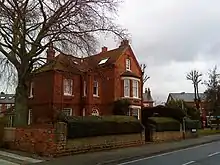Ernest Reginald Ridgway
Ernest Reginald Ridgway (1852 - 19 July 1917) was an English architect based in Long Eaton.

4 Glebe Street, 1878-79
Career
He was born in 1852 in Cheltenham, Gloucestershire, the son of William Ridgway (1819-1903) and Mary.
He married Mary Eliza Sketchley (1851-1904) in 1875 in Nottingham. On the death of his first wife in 1904, he married Louisa Goodwin Sketchley (1865-1926) on 5 November 1906 at St Heliers Parish Church, Jersey.
From 1893 to 1899 he had as his assistant John Frederick Dodd who later set up his own practice in Long Eaton, Derbyshire.
Until 1908 he worked in partnership with James Garfield Smith.[1]
He died on 19 July 1917 at his home, 11, Lenton Road, The Park Estate, Nottingham.[2] He left an estate valued at £13,129 (equivalent to £782,700 in 2021).[3]
Notable works
- Glebe Villas, 2 and 4 Glebe Street, St John's Grove, Beeston 1879
- Three houses, 26-30 Chilwell Road, Beeston, 1881
- Four Houses and shop, 44-52 Chilwell Road, Beeston, 1882
- Co-operative Society Slaughter House, Oakley’s Field, Long Eaton, 1893
- St John's Baptist Chapel, Clumber Street, Long Eaton 1895[4]
- Bemrose and Sons, Midland Place Printing Works, Park Street/Canal Street, Derby 1896[5]
- Bethel Primitive Methodist Church, Derby Road, Long Eaton 1898
- Co-operative Society Beverage Factory, Bailey Grove, Eastwood, 1899
- The Long Eaton Institute, Salisbury Street, Long Eaton, Derbyshire 1900[6]
- Wesleyan Central Church, Long Eaton 1903 (new organ chamber)
- St Christopher’s Church, Shaftesbury Crescent, Derby 1903.[7]
- Long Eaton Working Men’s Co-operative Society, Oak Ley’s Road, Long Eaton, 1904[8]
- New Mess Room, Ley’s Works, Colombo Street, Derby 1904.
- Chaddesden Lace Works, Nottingham Road, Derby 1904[9]
References
- "Public Notices". Derby Daily Telegraph. England. 2 January 1909. Retrieved 28 April 2019 – via British Newspaper Archive.
- "Deaths". Nottingham Evening Post. England. 20 July 1917. Retrieved 28 April 2019 – via British Newspaper Archive.
- UK Retail Price Index inflation figures are based on data from Clark, Gregory (2017). "The Annual RPI and Average Earnings for Britain, 1209 to Present (New Series)". MeasuringWorth. Retrieved 11 June 2022.
- "Ecclesiastical". Nottinghamshire Guardian. England. 9 November 1895. Retrieved 28 April 2019 – via British Newspaper Archive.
- "Messrs Bemrose and Sons, Limited". Derby Daily Telegraph. England. 29 August 1896. Retrieved 28 April 2019 – via British Newspaper Archive.
- "Long Eaton Institute". Long Eaton Advertiser. England. 30 November 1900. Retrieved 28 April 2019 – via British Newspaper Archive.
- "Opening of a new church at Derby". Long Eaton Advertiser. England. 19 June 1903. Retrieved 28 April 2019 – via British Newspaper Archive.
- "Long Eaton Co-operative Society". Nottingham Journal. England. 17 August 1904. Retrieved 28 April 2019 – via British Newspaper Archive.
- "Chaddesden Lace Works Institute". Derby Daily Telegraph. England. 25 April 1904. Retrieved 28 April 2019 – via British Newspaper Archive.
This article is issued from Wikipedia. The text is licensed under Creative Commons - Attribution - Sharealike. Additional terms may apply for the media files.